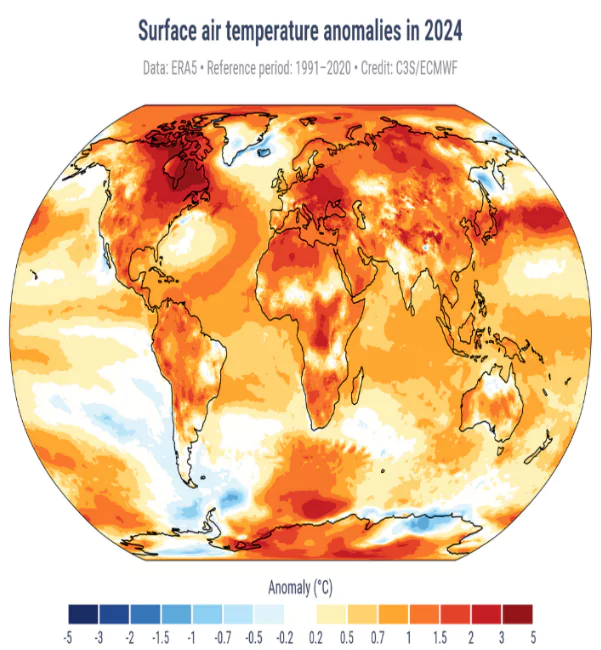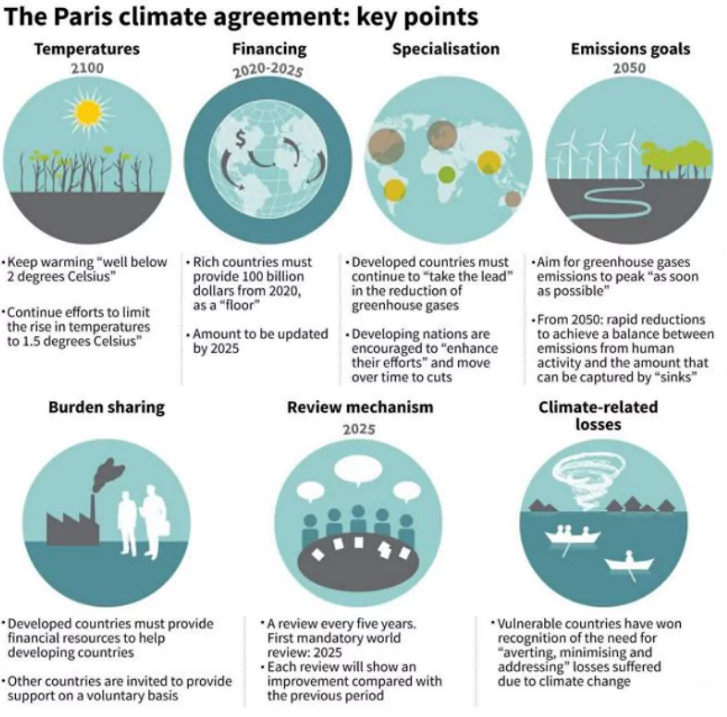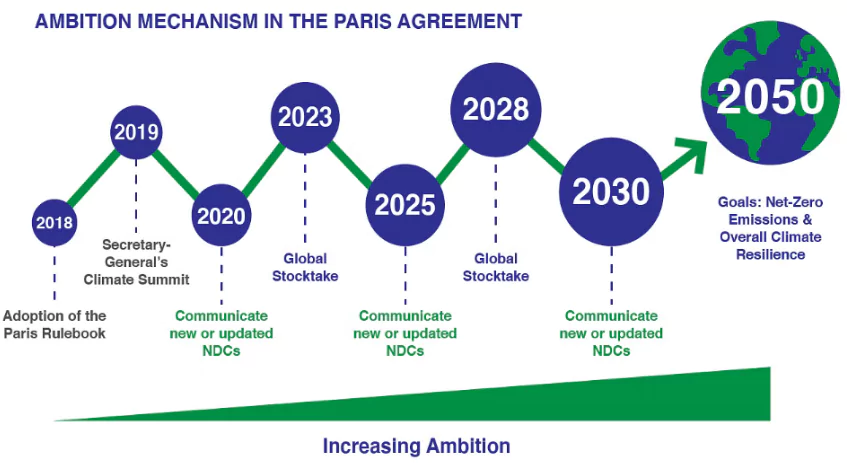2024 has become the first year to breach the 1.5 degree Celsius warming mark as per the Copernicus Climate Change Service (C3S).
- Average annual global temperature in 2024 was 1.55 degree Celsius higher than pre-industrial times (average of 1850-1900 period).
- WMO said each of the six datasets it had used had put 2024 as the warmest year ever, but not all of them recorded the warming to be in excess of 1.5 degrees Celsius.

About Copernicus Climate Change Service (C3S)
- Objective:
- A flagship program of the European Union, C3S provides comprehensive climate data, tools, and services to monitor and adapt to climate change.
- Data Coverage:
- Offers global and regional climate information, including temperature trends, sea level changes, and greenhouse gas concentrations, based on satellite and in-situ data.
- Applications:
- Supports policy-making, risk assessments, and climate resilience planning in sectors like agriculture, energy, water management, and urban planning.
- Open Access:
- Provides free, open, and user-friendly data via the Climate Data Store (CDS), fostering transparency and scientific collaboration.
- Global Collaboration:
- Collaborates with international organizations like the World Meteorological Organization (WMO), enhancing global climate monitoring and response efforts.
Enroll now for UPSC Online Course
Details about 2024 warming statistics
- At an average temperature of 15.1 degrees Celsius, 2024 was the warmest year in global temperature records, which go back till 1850.
- It was 0.72 degrees Celsius above the 1991-2020 average.
- It was also 1.60 degrees Celsius above an estimate of the 1850-1900 temperature designated to be the ‘pre-industrial’ level.
- Experts have said that given the high rate of carbon emissions at present, the 2024 temperatures represent a point of no return.
- Contributing Factors:
- El Niño Impact: It began in June 2023, lasted into 2024, exacerbating warming trends.
- This combined with greenhouse gas emissions to break records
- Sea Surface Temperatures (SST): Extra-polar SST reached a record high of 20.87°C, surpassing the 1991-2020 average by 0.51°C.
- July to December 2024 marked the second warmest period on record
- Implications:
- Point of No Return: Scientists suggest this milestone indicates the Earth is on track for exceeding 2°C warming by 2050
- Highlights the urgency of reducing carbon emissions
- Global Climate Policy Concerns:
- COP29 talks in Baku failed to agree on financial support for mitigating climate risks
- Developing economies face disproportionate impacts without adequate support.
- Importance of the 1.5°C Threshold:
-
- Paris Agreement Context:
- Adopted in 2015, the Paris Agreement aims to limit global temperature rise to well below 2°C above pre-industrial levels while striving to stay within 1.5°C
- Achieving the 1.5°C target would significantly reduce risks and impacts of climate change
- Long-Term Perspective: The 1.5°C or 2°C targets are based on long-term averages rather than short-term or year-to-year variations
- Monthly and daily breaches of 1.5°C have occurred multiple times in recent years but do not signify a failure of the Paris Agreement.
About Paris Climate Agreement

- Adoption:
- The Paris Agreement was adopted on December 12, 2015, during the 21st Conference of Parties (COP21) of the UNFCCC and came into force on November 4, 2016.
- Global Temperature Goal:
- It aims to limit global warming to below 2°C, preferably 1.5°C, above pre-industrial levels.
- Nationally Determined Contributions (NDCs):
- Countries submit NDCs outlining their climate action plans, updated every five years, to achieve the global temperature goal.
- Differentiated Responsibilities:
- Recognizes Common but Differentiated Responsibilities and Respective Capabilities (CBDR-RC), holding developed countries accountable for providing climate finance, technology transfer, and capacity-building.
- Long-term Goals:
- Achieve global net zero emissions in the second half of the 21st century.
- Enhance adaptive capacities and resilience to climate impacts.
- Finance and Support:
- Developed nations pledged to mobilize $100 billion annually by 2020, extended until 2025, for supporting climate action in developing countries.
- Global Participation:
- As of now, 195 parties have signed the agreement, with 194 ratifying it, making it a nearly universal commitment.
- Monitoring and Transparency:
- Implements a Global Stocktake every 5 years to assess progress and ensure accountability.
Check Out UPSC CSE Books From PW Store
India’s Targets under the Paris Agreement

- Emission Intensity Reduction:
- Reduce the emission intensity of GDP by 45% by 2030 compared to 2005 levels.
- Renewable Energy Capacity:
- Achieve 50% cumulative installed capacity from non-fossil fuel energy sources by 2030.
- Carbon Sink:
- Create an additional 2.5 to 3 billion tonnes of carbon dioxide equivalent through forest and tree cover by 2030.
- Net Zero Commitment:
- Achieve net zero emissions by 2070 as pledged at COP26 in Glasgow.
- Nationally Determined Contributions (NDCs):
- Align climate actions with sustainable development goals, focusing on energy efficiency, clean energy, and climate resilience.
![]() 11 Jan 2025
11 Jan 2025




